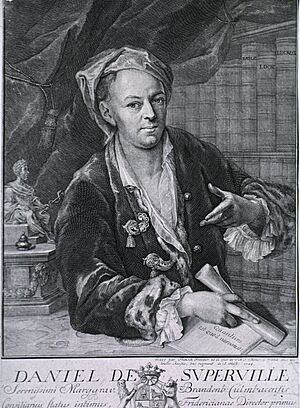Daniel de Superville (1696–1773) facts for kids
Daniel de Superville (born in Rotterdam, December 2, 1696 – died in Rotterdam, November 16, 1773) was a Dutch doctor. He is famous for starting the University of Erlangen in Germany in 1742. He was the head of the university, called its chancellor, until 1748. Daniel de Superville also wrote many books about anatomy, which is the study of the body's structure.
Contents
His Family Background
Daniel de Superville came from a French family called Huguenots. Huguenots were French Protestants who had to leave France to escape danger. His family fled to the Netherlands from a town called Saumur.
He was the third son of Jacques (Jacob) de Superville, who was a merchant, and Marguérite Vettekeuken. His uncle was a well-known Calvinist religious leader named Daniel de Superville (1657-1728).
Education and Early Career
Daniel de Superville went to the University of Leiden in 1719. He had already earned his doctorate degree a year earlier from the University of Utrecht. His special paper for his degree was about blood and how it's made.
In 1722, he married Catharina Elisabeth le Comte in Leiden. Soon after, they moved to Prussia. There, Daniel de Superville started working as a teacher of anatomy and surgery in a city called Stettin.
Becoming a Royal Doctor
Daniel de Superville became very well-known after he helped King Frederick Wilhelm I of Prussia. The King was suffering from a condition called edema, which causes swelling. After Superville helped him, he got a special job in 1738. He became the personal doctor for Princess Wilhelmine of Prussia. She was the sister of King Frederick II.
Superville quickly became an important advisor to Princess Wilhelmine and her husband, Frederick, Margrave of Brandenburg-Bayreuth. Because of his skills, he was invited to join the German imperial academy of sciences in Berlin in 1739. In 1741, he was also chosen to be a Fellow of the Royal Society, which is a very respected group of scientists in England.
Founding a University
Because of his influence, Frederick and Wilhelmina asked him to help start a new Protestant university. This university was founded in Bayreuth in 1743. Daniel de Superville was chosen to be its first rector magnificus, which is a very high leadership position.
One year later, the university moved to Erlangen. Frederick of Brandenburg-Bayreuth then became the rector magnificus himself. However, he kept Daniel de Superville as the chancellor, meaning he was still in charge of the university's daily operations. Today, the University of Erlangen is a very large and important university. It is the second biggest university in Bavaria, a state in Germany.
Later Life and Return to Rotterdam
Daniel de Superville continued to lead the university until 1748. After that, he moved to Braunschweig. From 1754, he managed the Herzog Anton Ulrich Museum. He also bought many coins in the Netherlands during this time.
In 1761, he settled in Voorburg, a town near The Hague. His first wife passed away, and he remarried in 1770. Finally, he returned to his hometown of Rotterdam. He died there at the age of 77. Daniel de Superville was buried at the Vrouwekerk in Leiden. This church was later taken down in 1819. At the time, it was used by the Walloon church, a French-speaking Protestant church.
Sources
- Kees Vellenga, "In het voetspoor van Röntgen 2008", Historische Commissie van de Nederlandse Vereniging voor Radiologie (Dutch)
- Wer ist wer in Bayreuth: Daniel de Superville (German)
- Nieuw Nederlandsch biografisch woordenboek, deel 6: Superville, Daniel de (3) (Dutch)
- "Superville, Daniel von" in: Allgemeine Deutsche Biographie, 1908 (German)


